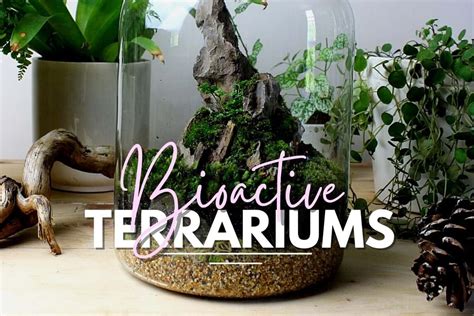Introduction
Bioactive terrariums are captivating miniature ecosystems that replicate the natural habitats of various organisms. These enclosed environments house a dynamic community of plants, animals, and microorganisms that work together in a symbiotic relationship. Bioactive terrarium plants play a crucial role in maintaining the ecosystem’s balance by providing shelter, food, and oxygen while absorbing waste and pollutants.

The Importance of Bioactive Terrarium Plants
-
Air Purification: Bioactive terrarium plants effectively absorb pollutants, such as ammonia and carbon dioxide, from the air. This helps to create a cleaner and healthier environment for the terrarium’s inhabitants.
-
Waste Decomposition: Plants utilize the waste products of animals and other organisms as nutrients. They break down organic matter and convert it into usable forms, promoting waste cycling and reducing odor.
-
Microhabitat Creation: Bioactive terrarium plants provide diverse microhabitats for various microorganisms, insects, and small animals. These microhabitats support a complex food web and enhance the overall biodiversity of the ecosystem.
10 Essential Bioactive Terrarium Plants
1. Creeping Fig (Ficus pumila)
- Provides dense ground cover and vertical climbing opportunities for animals.
- Helps to absorb excess moisture and create a humid microclimate.
2. Golden Pothos (Epipremnum aureum)
- Highly adaptable and easy to grow, tolerating a wide range of light conditions.
- Removes toxins from the air, making it beneficial for both plants and animals.
3. Spider Plant (Chlorophytum comosum)
- Produces long runners with plantlets, providing additional greenery and hiding places.
- Purifies the air and helps to maintain humidity levels.
4. Snake Plant (Sansevieria trifasciata)
- Low-maintenance plant that thrives in low light conditions.
- Releases oxygen at night, improving air quality during the terrarium’s inactive hours.
5. Peace Lily (Spathiphyllum wallisii)
- Known for its air-purifying abilities, removing harmful substances like formaldehyde.
- Prefers moderate light and humidity levels.
6. Prayer Plant (Maranta leuconeura)
- Unique foliage that folds up at night, giving the plant its playful name.
- Tolerates a range of light conditions and humidity levels.
7. Fernbrake Spikesedge (Kyllinga brevifolia)
- Grass-like plant that adds texture and interest to the terrarium floor.
- Helps to stabilize soil conditions and improve drainage.
8. Piggyback Plant (Tolmiea menziesii)
- Unusual plant with clusters of small, round leaves that resemble piggyback rides.
- Enjoys moist conditions and provides ample hiding places for small animals.
9. Button Fern (Pellaea rotundifolia)
- Small, button-shaped fern that adds a touch of delicacy to the terrarium.
- Requires high humidity levels and bright, indirect light.
10. Bromeliad (Tillandsia spp.)
- Air-dwelling plant that absorbs nutrients through its leaves.
- Provides perching sites for animals and adds a unique touch of tropical flair.
Benefits of Incorporating Bioactive Terrarium Plants
-
Improved Animal Health: Bioactive terrarium plants provide a healthier and more stimulating environment for animals, reducing stress and promoting well-being.
-
Reduced Maintenance: Plants help to maintain the ecosystem balance, reducing the need for frequent cleaning and substrate changes.
-
Enhanced Aesthetics: Bioactive terrarium plants add beauty and visual interest to the enclosed ecosystem, creating a natural and aesthetically pleasing display.
Conclusion
Bioactive terrarium plants are essential components of a thriving and balanced ecosystem. Their ability to purify air, decompose waste, and create microhabitats makes them vital contributors to the overall health and well-being of the terrarium’s inhabitants. By incorporating a diverse selection of bioactive plants, terrarium enthusiasts can create a flourishing mini ecosystem that mimics the natural world.





















